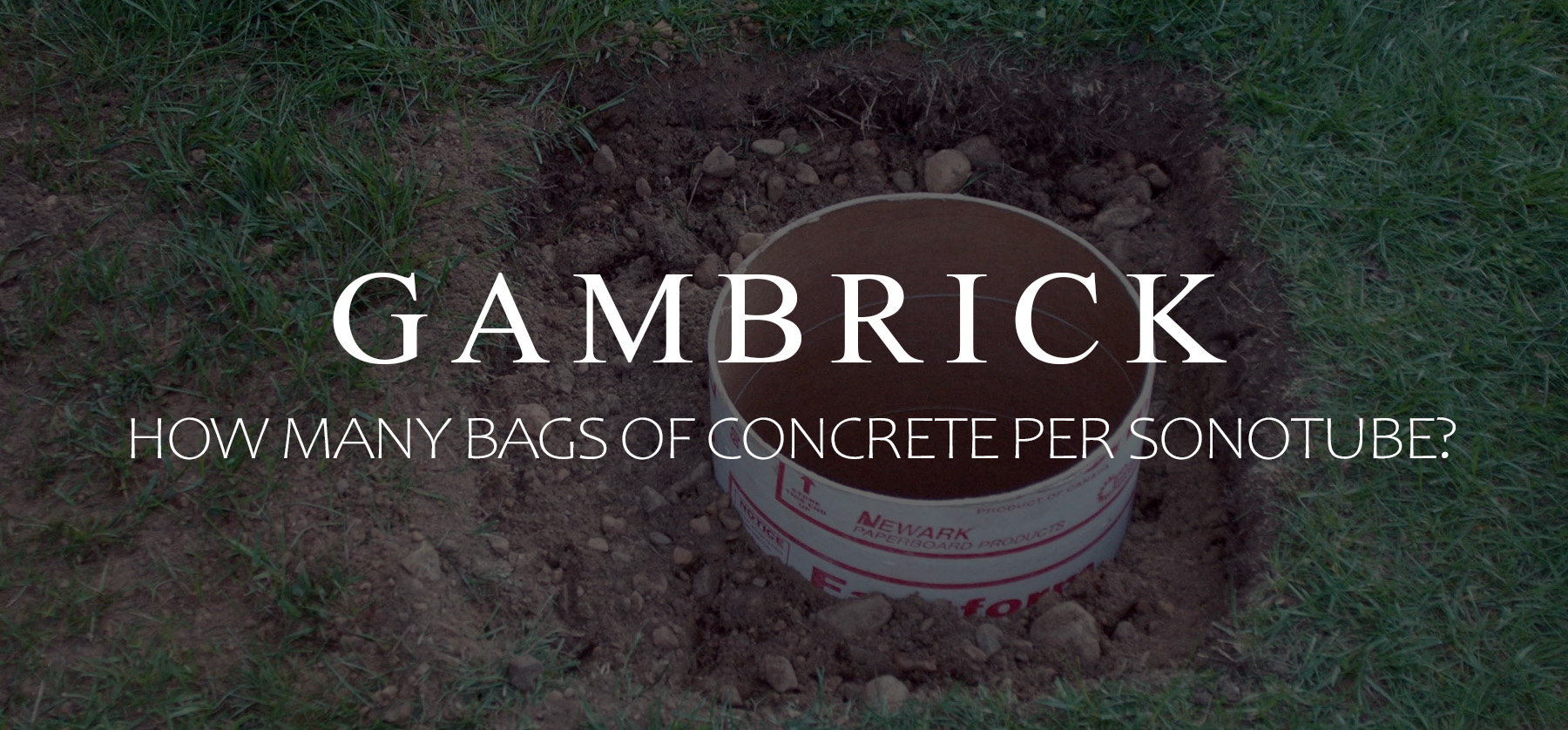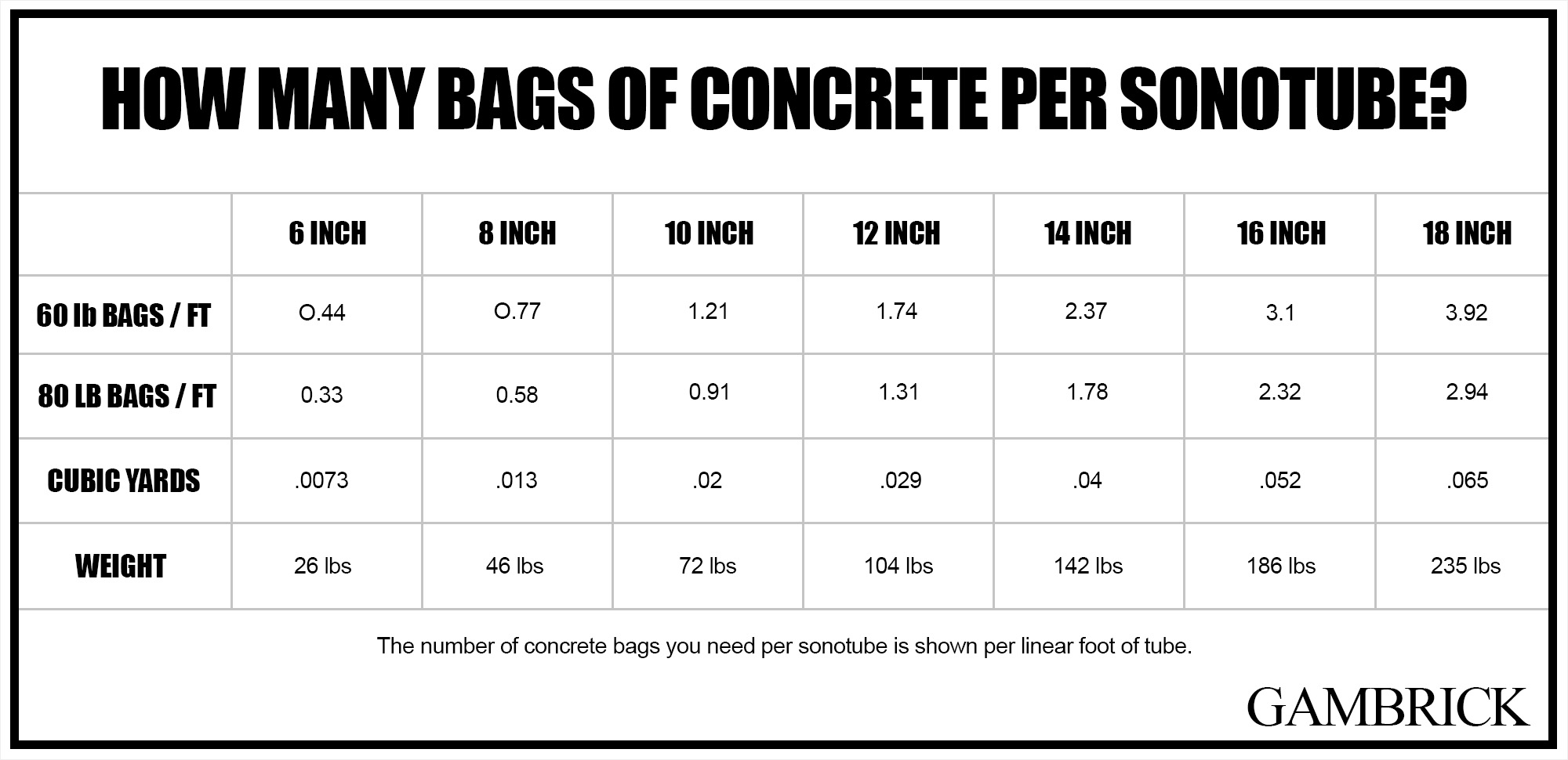
How Many Bags Of Concrete Per Sonotube
Sonotubes are cardboard tubes in which concrete is poured to form solid concrete pillars or footings. The word Sonotube is a trademarked brand name. Other companies like Sakrete and Quikrete make their own version of a sonotube. Sakrete’s is called a Form-Tube while Quikrete’s is a Quik-Tube. They’re all the same basic product, a round cardboard form you pour concrete into which creates a cylinder shaped pillar. The pillar can be poured underground to create a footing or above ground which is called a concrete pier. Sonotubes come in a variety of diameters which increase in 2 inch increments. The most common sizes are 8, 10, 12, 14, 16 and 18 inch by 48 inches tall. How many bags of concrete per sonotube depends on the tube’s diameter, the size of the bag and how many feet of tube you want to fill.
Because sonotubes are made from cardboard, they’re single use only. If the tubes are used below grade, they’ll naturally break down over time. Cardboard is 100% biodegradable. However, if the tubes are used above grade, they can be removed after the concrete has hardened. In some cases a release agent is used to help separate the tube from the concrete.
The most commonly used sonotube sizes are 8″, 10″ and 12″.
- It takes 1.74 x 60 lb bags or 1.31 x 80 lb bags of concrete to fill a 12″ sonotube 1 foot.
- You need 1.21 x 60 lb bags or 0.91 x 80lb bags of concrete to fill a 10″ sonotube 1 foot.
- It take 0.77 x 60 lb bags or 0.58 x 80 lb bags of concrete to fill an 8″ sonotube 1 foot.

How Many Bags Of Concrete Does It Take To Fill A Sonotube
The number of bags you need to fill a sonotube depends on the diameter of the tube, its height, and the size of the concrete bag. It takes 1.74 x 60 lb bags or 1.31 x 80 lb bags of concrete to fill a 12″ sonotube 1 foot. You need 1.21 x 60 lb bags or 0.91 x 80lb bags of concrete to fill a 10″ sonotube 1 foot. And it take 0.77 x 60 lb bags or 0.58 x 80 lb bags of concrete to fill an 8″ sonotube 1 foot.
The following chart shows how many bags of concrete you need to fill different size sonotubes per foot. This makes calculating a concrete job much easier. Simply multiply the amount of bags you need per foot by how high your sonotube is.
| 6” Sonotube | 8 ” Sonotube | 10 ” Sonotube | 12 ” Sonotube | 14 ” Sonotube | 16 ” Sonotube | 18 ” Sonotube | |
|---|---|---|---|---|---|---|---|
| Cubic Yards | .0073 | .013 | .02 | .029 | .04 | .052 | .065 |
| Concrete Weight | 26 lbs. | 46 lbs. | 72 lbs. | 104 lbs. | 142 lbs. | 186 lbs. | 235 lbs. |
| 60 lbs Bags | 0.44 | 0.77 | 1.21 | 1.74 | 2.37 | 3.1 | 3.92 |
| 80 lbs Bags | 0.33 | 0.58 | 0.91 | 1.31 | 1.78 | 2.32 | 2.94 |
Sonotubes sold at Home Depot or Lowes usually come in 48 inch lengths. However, you can special order tubes that are much longer.
In general, a sonotube can only extend 3 feet above ground. But you can bury them underground as deep as you need.
It’s also useful to know how many bags of concrete equal a yard, because most concrete projects are figured in terms of yards and not pounds or square footage. This is because a yard is a volume calculation.
Why Use A Sonotube?
Sonotubes are light weight and very easy to use. They’re round forms used to turn wet concrete into a solid cylinder when the concrete dries. You can cut them down to whatever height you need with a saw or utility knife. They’re also very strong and able to withstand the weight and pressure of concrete. When you use them above grade, they’ll retain a cylinder shape even when filled with concrete.
Sonotubes are used for a variety of concrete column applications, such as:
- Home or deck pilings or footing
- Goal or sign posts
- Fence posts
- Mailboxes or lamp posts
- Footings
- Use below grade and up to 3’ above grade
When sonotubes are used above ground as a pier, you should reinforce them above 2 feet to keep them upright, level and stable.
You should select a sonotube height and diameter that fits the project, for example, when setting a mailbox post. Then determine how many bags of concrete it takes to set the mailbox post for the sonotube size you chose.
This can also help you determine how many bags of concrete needed to set a fence post, deck post, flag pole, or anything other type of post in a tube.
How To Use A Sonotube
Using a sonotube is easy because they’re strong, easy to cut and light weight.
Place: First, dig a hole to the required depth. Place the tube into the hole. Back-fill dirt around the outside of the tube to secure it. If the tube extends more than 2 feet above grade, use some wood to support it.
Fill: Next, make sure the Sonotube concrete form is dry before filling it with concrete. Sonotubes are single-use forms. I recommend erecting all the tubes for your job in advance and then pouring the concrete all at once. This saves time and money. Shovel concrete directly into the tube, use a shoot or pump. I usually spread some gravel at the base of the tube prior to pouring concrete.
Strip: Sonotubes can be left in place or removed after the concrete dries. A release agent helps separate the form from the concrete. Remove the forms as soon as possible after a 24-hour curing period. Cut the forms vertically, using a knife or power saw, and the strip them away from the concrete.
Storage: Place tubes on an elevated platform at least 4 inches off the ground and cover them. Allow air to circulate through the tubes to keep them dry.
Caution: Don’t use a mechanical vibrator when placing concrete in the Sonotube. It’s important that your Sonotube remains stationary until the concrete sets.A vibrator won’t damage the form but it could move it unless you brace the tube securely.
How Do You Calculate Concrete For A Tube?
Calculating the amount of concrete you need to fill a tube is easy using the chart I’ve shown above.
First, determine what size diameter tube you’ll be using. They typically come in sizes 6, 8, 10, 12, 14, 16 and 18 inches.
Next, figure out how high the tube will be. Most sonotubes come in 4 foot lengths but you can special order them much longer. generally, they can’t extend more than 3 feet out of the ground and need reinforcement above 2 feet high.
Once you know the length and diameter tube you’ll be using, reference the chart to find out how many bags of concrete you need to fill the tube per foot. Then multiply by the amount of feet the tube is.
For example, an 8 inch diameter tube that’s 3 feet long requires 2.31 60 lbs bags or 1.74 80 lbs bags to fill it.
You can use the same method to calculate how many cubic yards of concrete are needed to fill the sonotube and even how much the tube will weigh.
Do I Need Rebar Inside A Sonotube?
In some cases rebar is required inside a sonotube and in some cases not. It all depends on the application and what you’re building. Whether or not your tube requires rebar inside will be specified on the blueprints. But how does that effect the amount of concrete needed to fill the tube?
In some cases, such as piers that extend above grade, rebar can be inserted vertically into the tube to add strength an some flexibility. Rebar is a great way to increase a concrete slabs tensile strength.
Rebar takes up volume inside the sonotube. So to be totally accurate, you’d have to deduct the volume of the rebar from the amount of concrete you need to fill the tube. However, I never do it. It’s just a small amount of concrete that gets displaced by the rebar.
Should I Use Gravel At The Bottom Of A Sonotube?
I almost always spread some gravel at the base of a sonotube. A bit of gravel at the bottom provides some drainage and a solid base for the concrete.
One thing you want to avoid when pouring a footing is creating a tip. A concrete pier with a tipped bottom can work it’s way down into the soil when weight is applied to it. However, if the concrete pier has a flat base it shouldn’t sink when weight is applied.
Water can cause a concrete pier to settle. But a bit of gravel helps drain water away which help prevent settling.
You don’t always have to spread gravel at the base of a sonotube, but it’s a good habit to get into Unless the blueprints tell me not to do it, I usually do.
Should A Sonotube Be Filled To The Top?
I always cut my sonotubes to length and fill them to the top. When concrete is poured to the top of the tube it allows me to trowel the top smooth. This not only looks better but also reduces the amount of surface pores. Because concrete is a porous material that absorbs water, it’s best to reduce the pores as much as possible.
You don’t have to fill the tube all the way to the top with concrete, it’s OK to fill them only partially and then cut them later. However, I like to trowel smooth the surface.
Pouring concrete to the top of the tube also helps if you need to insert metal tie downs, plates or bolts into the pier. You generally want to insert these while the concrete is wet and it’s much easier if a cardboard tube isn’t in the way.
How Many Bags Of Concrete To Fill A 6″ Sonotube?
How many bags of concrete you need to fill a 6″ sonotube depends on the size of the bag. The two most popular concrete bag sizes are 60 lbs. and 80 lbs. A 6 inch sonotube requires 0.44 x 60 lbs. or 0.33 x 80 lbs. bags of concrete to fill it one foot. That’s .0073 cubic yards or 26 lbs. of concrete.
To fill an entire 48 inch sonotube you need 1.74 60 lbs. bags or 1.31 80lbs. bags of concrete. That’s .029 yards or 104 lbs. of concrete.
How Many Bags Of Concrete To Fill An 8″ Sonotube?
How many bags of concrete you need to fill an 8″ sonotube depends on the size of the bag. The two most popular concrete bag sizes are 60 lbs. and 80 lbs. An 8 inch sonotube requires 0.77 x 60 lbs. or 0.58 x 80 lbs. bags of concrete to fill it one foot. That’s .013 x cubic yards or 46 lbs. of concrete.
To fill an entire 48 inch sonotube you need 3.1 60 lbs. bags or 2.32 80lbs. bags of concrete. That’s .052 yards or 185 lbs. of concrete.
How Many Bags Of Concrete To Fill A 10″ Sonotube?
How many bags of concrete you need to fill a 10″ sonotube depends on the size of the bag. The two most popular concrete bag sizes are 60 lbs. and 80 lbs. A 10 inch sonotube requires 1.21 x 60 lbs. or 0.91 x 80 lbs. bags of concrete to fill it one foot. That’s .029 x cubic yards or 72 lbs. of concrete.
To fill an entire 48 inch sonotube you need 4.84 60 lbs. bags or 3.63 80lbs. bags of concrete. That’s .081 yards or 290 lbs. of concrete.
How Many Bags Of Concrete To Fill A 12″ Sonotube?
How many bags of concrete you need to fill a 12″ sonotube depends on the size of the bag. The two most popular concrete bag sizes are 60 lbs. and 80 lbs. A 12 inch sonotube requires 1.74 x 60 lbs. or 1.31 x 80 lbs. bags of concrete to fill one foot. That’s .029 cubic yards or 104 lbs. of concrete.
To fill an entire 48 inch sonotube you need 7 x 60 lbs. bags or 5.22 x 80lbs. bags of concrete. That’s .12 yards or 417 lbs. of concrete.
Summary: How Many Bags Of Concrete Per Sonotube?
Sonotubes are cardboard tubes in which concrete is poured to form solid concrete pillars or footings. The word Sonotube is a trademarked brand name. Other companies like Sakrete and Quikrete make their own version of a sonotube. Sakrete’s is called a Form-Tube while Quikrete’s is a Quik-Tube. They’re all the same basic product, a round cardboard form you pour concrete into which creates a cylinder shaped pillar. The pillar can be poured underground to create a footing or above ground which is called a concrete pier. Sonotubes come in a variety of diameters which increase in 2 inch increments. The most common sizes are 8, 10, 12, 14, 16 and 18 inch by 48 inches tall. How many bags of concrete per sonotube depends on the tube’s diameter, the size of the bag and how many feet of tube you want to fill.
Because sonotubes are made from cardboard, they’re single use only. If the tubes are used below grade, they’ll naturally break down over time. Cardboard is 100% biodegradable. However, if the tubes are used above grade, they can be removed after the concrete has hardened. In some cases a release agent is used to help separate the tube from the concrete.
The most commonly used sonotube sizes are 8″, 10″ and 12″.
- It takes 1.74 x 60 lb bags or 1.31 x 80 lb bags of concrete to fill a 12″ sonotube 1 foot.
- You need 1.21 x 60 lb bags or 0.91 x 80lb bags of concrete to fill a 10″ sonotube 1 foot.
- It take 0.77 x 60 lb bags or 0.58 x 80 lb bags of concrete to fill an 8″ sonotube 1 foot.
If you have any questions about using a Sonotube, email any time.

John Mazzuca | About | More Posts |
Custom Home Builder
John Mazzuca is a custom home designer and builder at Gambrick with over 25 years experience in the construction industry. John has designed, built and/or remodeled hundreds of homes, small buildings, and commercial projects. He writes about business, real estate, home building, and household electronics. His work has been featured in Fox Business, Better Homes & Garden, House Beautiful, and more.




















